Padstow
OS Grid ref:- SW918751
The ancient town of Padstow, on the North Cornwall coast, was originally referred to as Petrocstow, after the Dark Age missionary St. Petroc. Petroc, reputed to be the son of a Welsh Prince, arrived from Ireland in around 520 AD and settled here. He is said to have converted the Celtic King Constantine to Christianity. After Petroc's death, a monastery called Lanwethinoc was built on the hill above the harbour in Padstow, which was destroyed by the Vikings in the tenth century. In medieval times the town was commonly referred to as Aldestowe ('old place' in contrast to Bodmin, the 'new place'). The modern Cornish form Lannwedhenek derives from Lanwethinoc.
Padstow Harbour
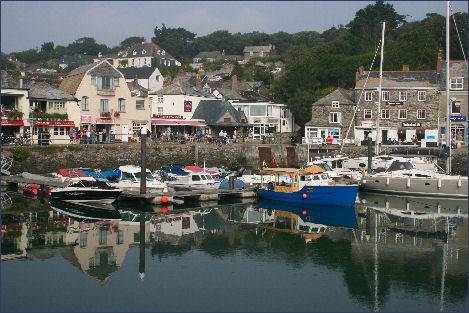
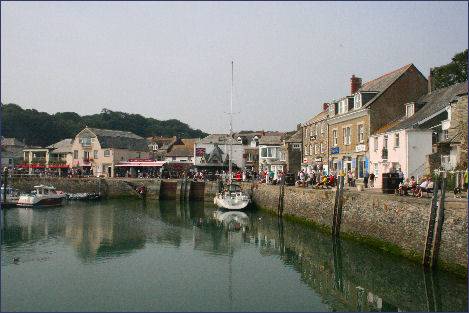
Nestling on the Camel estuary, Padstow's winnding streets slope down to the harbour. Some of the town's quaint and characterful buildings date from the medieval era. The church of St Petroc is one of four said to have been founded by the saint, the others being Little Petherick,Parracombe and Bodmin. Old inns and stone cottages with their colourful sheltered front gardens line the route to the peaceful harbour where the fishing fleet lies moored and where pleasure boats offering bay cruises now abound. From the slipway beside the tourist office the Black Tor ferry runs regular services across the estuary to Rock. ( daily, except Sun in Nov - March)
Characterful Padstow Streets
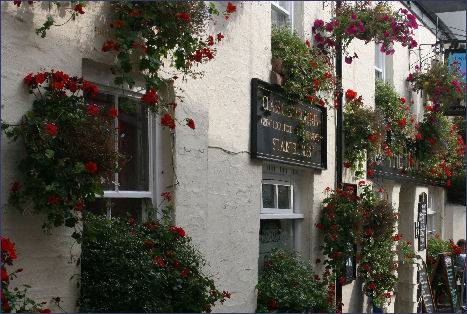
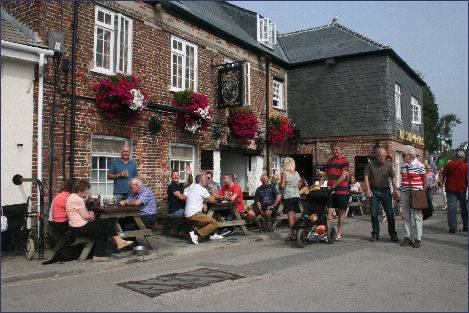
Padstow is the most sheltered port on the north coast of Cornwall, large vessels are prevented from entering the Camel estuary by the infamous Doom Bar, a treacherous sandbank which has been the cause of over 600 shipwecks since records began around 200 years ago. Local legend stated that the Doom Bar is the result of a mermaids curse.
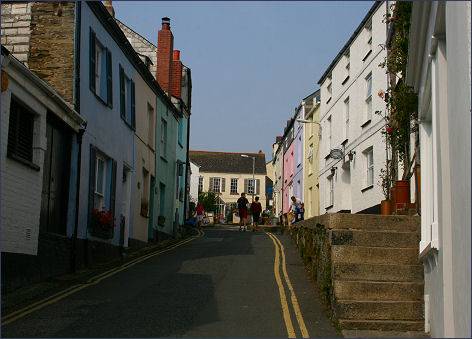

Padstow offers no less than three golf courses for enthusiasts, at the seaside links of St. Endonoc, Trevose and the nearby Merlin Golf Club. The famed Rick Stein's Seafood Restaurant, overlooks the harbour. The Seafood Restaurant opened the seventies and grown from a seaside bistro to an award-winning restaurant with an international reputation.
 In the sixteenth century Padstow provided shelter to the famous Elizabethan seaman, Sir John Hawkins as he made his way back from the West Indies and also to Sir Martin Frobisher on his way back from his search for the North West Passage to China in 1577. Sir Walter Raleigh, a former resident of Padstow when he was Warden of Cornwall , once presided over the sixteenth century courthouse on south quay. Although still standing, the Court House and his cottage are not open to the public.
In the sixteenth century Padstow provided shelter to the famous Elizabethan seaman, Sir John Hawkins as he made his way back from the West Indies and also to Sir Martin Frobisher on his way back from his search for the North West Passage to China in 1577. Sir Walter Raleigh, a former resident of Padstow when he was Warden of Cornwall , once presided over the sixteenth century courthouse on south quay. Although still standing, the Court House and his cottage are not open to the public.
 Padstow's small but interesting museum is situated in the Market Place, it was initially founded in 1971 by an enthusiastic group of local residents headed by retired boat builder Bill Lindsey, it holds a unique collection of artefacts, giving an insight into the history of the Port of Padstow over the past two centuries.
Padstow's small but interesting museum is situated in the Market Place, it was initially founded in 1971 by an enthusiastic group of local residents headed by retired boat builder Bill Lindsey, it holds a unique collection of artefacts, giving an insight into the history of the Port of Padstow over the past two centuries.
The cobbled byways and streets climb the valley sides up to the church of St. Petroc. The present church was constucted between 1425 and 1450 and replaced an earlier twelfth century Norman church. The fourteenth century font is decorated with carvings of the twelve Apostles, three on each side, each identifiable by what he is carrying, while the old the wooden town stocks stand the South West corner of the church. In the south-west corner is a large memorial to Sir Nicholas Prideaux, the sixteenth century builder of Prideaux Place. The "wineglass pulpit is believed to date to around 1530. In the churchyard are two very old figures of headless lion and the chained hart, the badge of King Richard II, 1377 - 1399, which pre-date the church
Just above the church are the grounds of Prideaux Place, an Elizabethan manor dating from 1592, the house was home to the Prideaux-Brune family. The house has a deer park and a restored formal garden. The interesting library is Georgian Gothic and the Great Chamber has an elaborate ceiling depicting biblical scenes.
At nearby St. Endonoc Church stands the grave of the poet laureate and great lover of Cornwall, Sir John Betjemen.
The 'Obby 'Oss Festival
The 'Obby 'Oss Festival, a unique folk gathering, celebrating the ancient Cornish custom of the 'Obby 'Oss is held at Prideaux Place every year on 1st May.
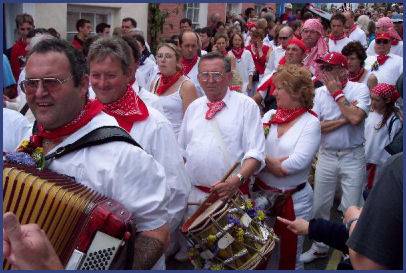
Athough the origins of the festival are not known, it is thought to stem from an ancient fertility rite, possibly the Celtic religious festival of Beltane. The festival commences at midnight on May Eve when the participants gather outside the Golden Lion Inn to sing the "Night Song." Padstow is then dressed with greenery and flowers around the maypole. The 'Obby 'Osses, male dancers, then parade through the town dressed as one of two 'Obby 'Osses, the "Old" and the "Blue Ribbon" 'Obby 'Osses; as the name suggests, are stylised kinds of horses.
Walks from Padstow
The Saint's Way
An ancient 26 mile (42km) track across Cornwall, known as the Saint's Way, commences at Padstow harbour. The track was originally used by Bronze and Iron Age traders, in the proceeding centuries, Celtic Christians also used the path, stopping to erect granite crosses.
A walk along a section of the Saint's Way
Distance 7 miles
Duration - around 3 - 4 hours
*From the lych gate at Padstow church proceed along Hill street, then cross New Street and continue along Dennis Lane. Pass the boating lake and turn left at a footpath sign. Continue to follow the Saint's Way for around 3 miles.
*After passing Little Petherick church, the Saint's Way at this point and follow the yellow arrows, crossing a stile then stepping stones and a footbridge to St. Issey church.
*Leave by the north gate and cross the road. Follow the yellow arrow to the right and then turn left after a stile, cross a footbridge and remain on the path passing through a gate keeping the hedge on the right. Turn right upon reaching a road, then left, after a quarter of a mile take the right signed path.
*Continue over a grassy bridge up the left of a long field to reach a gate at another road. Continue on following the signs for 'Old Town Creek' to reach the River Camel. Leave the Halwyn car park, climbing steps to the old railway line, now the Camel Trail and turn left to return to Padstow.
The Camel Trail
Covering 17 the Camel Trail follows the course of the old railway line along the Camel estuary between Blisland and Padstow. The trail can be joined at various points along its route and is open to cyclists and horse riders as well as walkers.